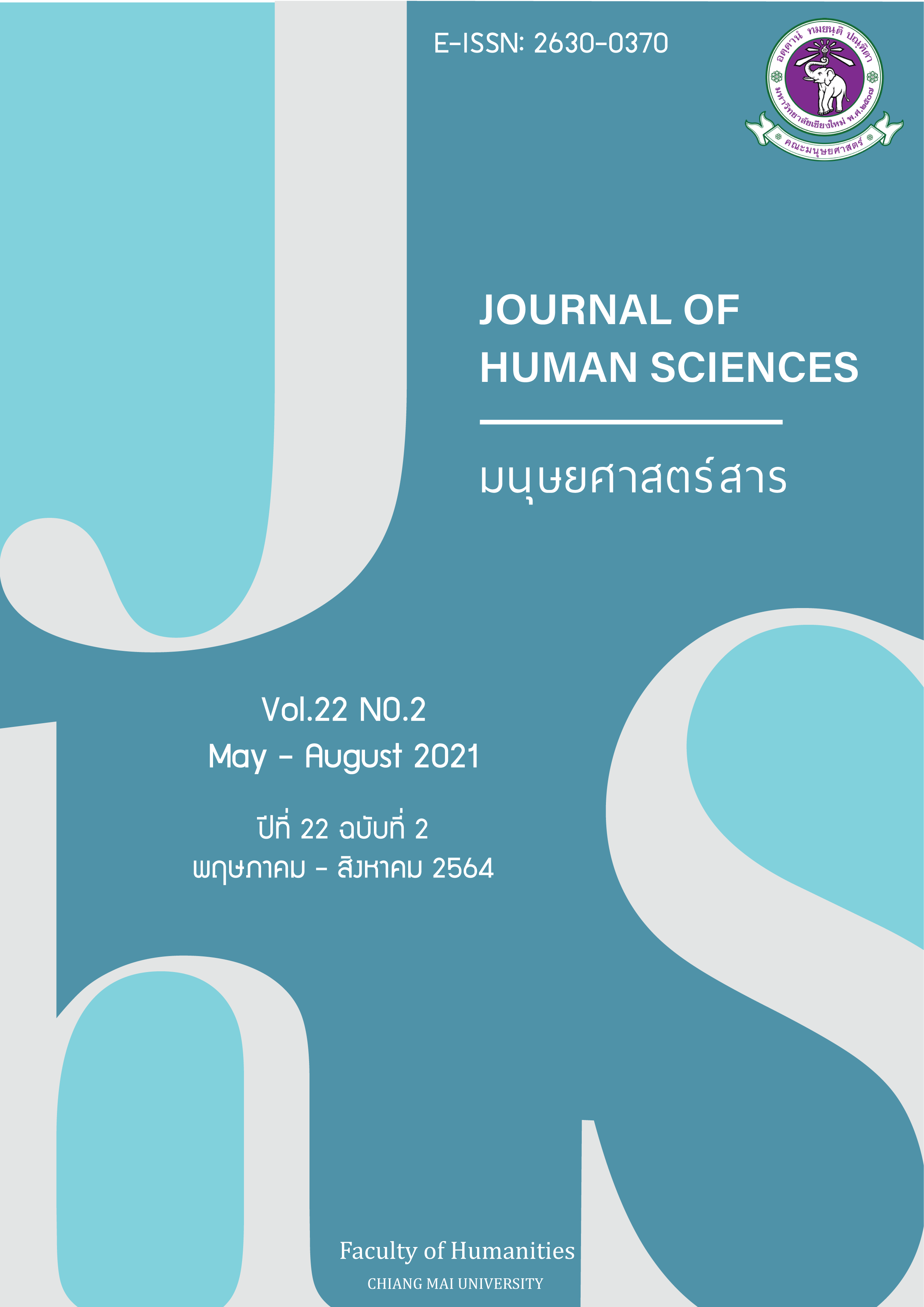ลักษณะเด่นและบทบาททางสังคมของวรรณกรรมคำสอนศาสนาอิสลาม ในวารสารมุสลิม กทม. นิวส์
Main Article Content
บทคัดย่อ
การวิจัยครั้งนี้มีวัตถุประสงค์การวิจัยเพื่อวิเคราะห์ลักษณะเด่นด้านเนื้อหา ลักษณะเด่นด้านกลวิธีการสอน และเพื่อวิเคราะห์บทบาททางสังคมของวรรณกรรมคำสอนศาสนาอิสลามในวารสารมุสลิม กทม. นิวส์ ข้อมูลในการวิจัยได้แก่ วรรณกรรมคำสอนประเภทบทความคำสอนที่เป็นลายลักษณ์ร้อยแก้ว เก็บรวบรวมจากวารสารรายเดือน “วารสารมุสลิม กทม. นิวส์” ตั้งแต่ฉบับแรก (ฉบับประจำเดือนกรกฎาคม พ.ศ. 2557) จนถึงฉบับปัจจุบัน (ฉบับประจำเดือนเมษายน พ.ศ. 2563) จำนวน 52 ฉบับ รวมข้อมูลวรรณกรรมคำสอนทั้งสิ้น 205 เรื่อง จากนั้นนำข้อมูลมาวิเคราะห์ตามวัตถุประสงค์การวิจัย ผลการวิจัยด้านลักษณะเด่นของเนื้อหาพบว่า ตัวบทคำสอนมีเนื้อหามุ่งสั่งสอนทั้งบุคคลทั่วไป และสอนเฉพาะกลุ่มบุคคล ลักษณะเด่นด้านเนื้อหาที่มุ่งสอนบุคคลทั่วไป ได้แก่ คำสอนเรื่องความจงรักภักดีต่อสถาบันพระมหากษัตริย์ การใช้วิจารณญาณในการรับสาร ความสมานฉันท์ การใช้ไหวพริบ สติปัญญาแก้ไขปัญหา การบริจาค ความกตัญญูต่อบิดามารดา การไม่ซื้อสิทธิ์ขายเสียง ความมุ่งมั่น การไม่ละเมิดผู้อื่น มารยาทในการติดต่อกิจธุระ และการแก้ปัญหาที่ต้นเหตุ ลักษณะเด่นด้านเนื้อหาที่มุ่งสอนเฉพาะกลุ่มบุคคล ได้แก่ คำสอนเรื่องหลักศรัทธา 6 ประการ หลักปฏิบัติ 5 ประการ การเชิญชวนผู้อื่นเข้าสู่ศาสนาอิสลาม (ดะวะฮ์) ธุรกิจอิสลาม นิติศาสตร์อิสลาม (ฟิกฮ์) การประกันภัยอิสลาม (ตะกาฟุล) การเชือดสัตว์พลี (กุรบาน) การพัฒนาคุณภาพชีวิต การมีจิตสาธารณะ การพัฒนาภูมิทัศน์ การจัดการที่ดินวะก็อฟ การปรับตัวในสังคมใหม่ และการอธิบายทำความเข้าใจกับสังคมเดิม ลักษณะเด่นด้านกลวิธีการสอน พบว่าผู้เขียนใช้กลวิธีการสอนที่หลากหลายและน่าสนใจ ได้แก่ สอนโดยการอ้างอิงจากหลักวินิจฉัยกฎหมายอิสลาม และประวัติศาสตร์อิสลาม การใช้ชีวประวัติ การขยายความจากเอกสารราชการ การแสดงผลของการกระทำ การใช้ภาพพจน์ การใช้ข่าวหรือเหตุการณ์ การใช้เรื่องตลก และการใช้ภาพหรือแผนภูมิประกอบ บทบาททางสังคม พบว่าวรรณกรรมคำสอนศาสนาอิสลาม ในฐานะข้อมูลทางคติชนวิทยามีบทบาททางสังคม ได้แก่ บทบาทการส่งเสริมจริยธรรม การให้ความรู้ การยืนยันความสำคัญของพิธีกรรมทางศาสนาอิสลาม การเผยแผ่ศาสนาอิสลาม การแจ้งข้อมูลข่าวสาร การบันทึกเหตุการณ์ทางประวัติศาสตร์ การสร้างความบันเทิง การตอบโต้วาทกรรมในสังคม และการเสริมสร้างสุขภาพอนามัยที่ดี ซึ่งทั้งหมดมีอิทธิพลต่อผู้คนในสังคมทั้งในระดับปัจเจกบุคคลและระดับชาติ นอกจากนี้บทบาททางสังคมบางประการยังสะท้อนให้เห็นอัตลักษณ์ของชาวไทยมุสลิม ทำให้เห็นว่าชาวมุสลิมพยายามจะธำรงอัตลักษณ์ของตนไว้ ในขณะเดียวกันก็มีความมุ่งมั่นในการยกระดับจิตใจของผู้คน สร้างสรรค์สังคมให้สมบูรณ์แบบตามแนวทางของศาสนาอิสลามด้วย
Article Details
เอกสารอ้างอิง
Khana song wat phrachetuphon. (2001). Chan At Da Phanon in Prachum charuk wat phrachetuphon. Bangkok: Princess Maha Chakri Sirindhorn Anthropology Centre.
Phawakkhraphan, N. (2015). Chuan thok chat læ chattiphan. Bangkok: Sayam.
Laosunthon, N. (1997). Phumpanya khong Khon Thai: suksa chak wannakam khamson. Bangkok: Thailand Research Fund.
Binkasan, B. (2000). Chanyaa marayat nai Itsalam. Bangkok: Islamic Book Center.
Binkasan, B. (2004). Saranukrom Itsalam chabap yaowachon læ phu rœm sonchai. Bangkok: Al Ameen.
Suwanrit, W., et al. (2006). Withi Thai. Bangkok: Ondeonstore.
Charoenrad, W. (2011). Kansưksa kan tang chu khong chao Thai Mutsalim chumchon matsayit ton son khet bang kok yai Krung Thep Maha Nakhon. (Master of arts thesis, Thammasat University).
Charoenrad, W. (2018). Chu matsayit nai Krung Thep Maha Nakhon: phasa læ kansusan thang watthanatham. Bangkok: Dhonburi Rajabhat University.
Chitmuad, S. (1992). Watthanatham Itsalam. (3rd ed.). Bangkok: Thangnam.
Samnakngan khana kammakan Itsalam pracham Krung Thep Maha Nakhon. (2014). Warasan Mutsalim kotomo niw chabap thi 1-52. Bangkok: Islamic Affairs National Center.
Umarn, U. (2018). Mutsalim lao lao Mutsalim: attalak Mutsalim changwat chaidæn phak tai nai ruang lao sarakhadi chiwit. (Master of arts thesis, Thammasat University).
Charles, F. (1979). Ethnic Adaptation and Identity: The Karen on the Thai Frontier with Burma. Philadelphia: Institute for the study of Human Issues.
Geertz, C. (1963). “The Integrative Revolution: Primordial Sentimes and Civil Politics in the New States." in Old Societies and NS "States: The Quest for Modernity in Asia and Africa (edited by ford Geertz). NY: Free Press.
Ogburn, W. (1946). The Social Effects of Aviation. Boston: MA Houghton Mifflin.
Thomas H. E. (1993). Ethnicity and Nationalism: Antropological Perspectives. London: Pluto Press.


